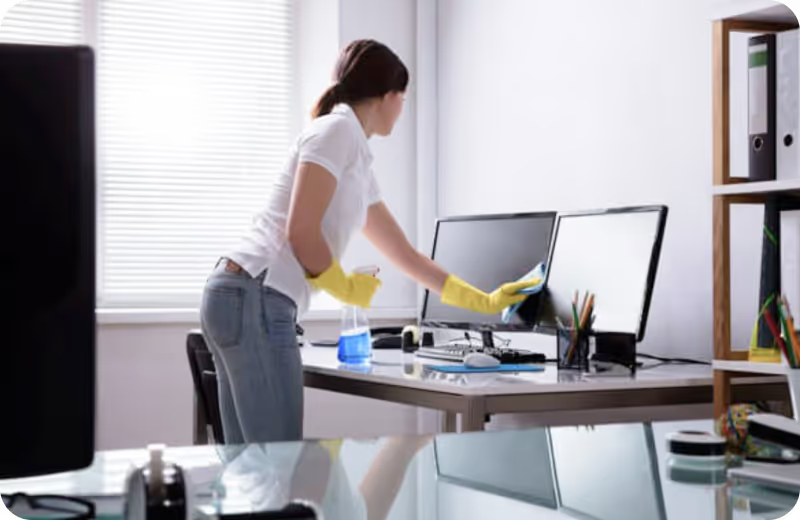
Stainless steel surfaces are well-preferred in kitchens as they do not absorb odors, oils, or dyes from food stains, making them perfect to use in food preparation. However, while stainless steel appliances do not absorb stains, they can have grime stuck on them that ruin the material.
In this article, we'll give you the step by step guide on cleaning stainless steel appliances in your kitchen using food-safe cleaning solutions with ingredients you may already have in your pantry!
What You'll Need
There are three steps on cleaning stainless steel appliances: general cleaning removes the surface dirt, grime, and general dust; stain removal gets rid of those unsightly marks left behind from food particles; and polishing uses oils to give your stainless steel appliance a shiny finish. You'll need these to start:
- Dish soap
- Water
- Microfiber cloth or Paper towel
- Baking soda
- White vinegar
- Olive oil or Baby oil
General Cleaning
Step 1: Wipe the Stainless Steel with a Dry Cloth
First, dry the stainless steel surface using a clean cloth to remove any loose dust or debris. This will help clear the surface for the cleaning solution to work better. This will also remove any grime that may spread during the cleaning process.
Step 2: Mix Your Cleaning Solution
Mix together 1 teaspoon of dishwashing liquid for every 1 cup of water. You may opt to add a teaspoon of vinegar as well for an extra cleaning boost, but this is optional. This cleaning solution can be used on stainless steel countertops, pots, pans, range hoods, coffee makers, tabletop dishwashers, sinks, faucets, and more.
Step 3: Clean Stainless Steel with Soap Solution
Use the dish soap solution, and dip a microfiber cloth into it. You may need to use a little elbow grease for particularly grimey areas, but you will need to wipe the stainless steel surface clean with the solution. Alternatively, you may apply the cleaning solution using a spray bottle, wiping with a clean cloth as you go.
Removing Stains
Step 1: Mix a Cleaning Paste and Apply
Create a cleaning paste using baking soda with just enough vinegar to create a thick solution. Apply the solution directly onto stained areas, and make sure you cover the entire area with the cleaning paste for the full effect.
Step 2: Let it Sit
Let the paste sit until it dries. You can opt to spray vinegar at this point to remove stubborn stains, or clear the residue from the paste away. We recommend applying a second coat of the cleaning paste for old and dark stains as you may need more than one application to completely remove it.
Step 3: Wipe the Paste Away
Wipe the paste away, going in a circular motion to scrub the loosened grime clean. Use a damp cloth to "rinse" the stainless steel appliance to remove any remaining residue.
Polishing
Step 1: Clean the Stainless Steel Surface with Vinegar
Add some vinegar onto a clean cloth, and wipe down the surface to remove any remaining residue: either residue from oils and grease, or cleaning solution residue. This will prepare your stainless steel appliances for sealing and seasoning. Let the vinegar dry completely.
Step 2: Dab Olive Oil or Baby Oil
Although it may seem counteractive, applying a very thin coat of olive or baby oil helps prevent corrosion and rust as it seals the stainless steel surface from moisture and stains. Dab a couple of drops of oil into a paper towel, and wipe all over the stainless steel.
For stainless steel cookware, use a food-safe oil with a low smoking point, such as flaxseed oil, but olive oil works as well. Season with a thin layer of oil spread onto your stainless steel cookware, and place in a 450 degree oven for an hour. Then, turn the oven off, and let the pan cool in the oven. This will create a non-stick surface for your pan, and prevent it from rusting.
Step 3: Run Over the Stainless Steel Surface with a Dry Microfiber Cloth
After you've polished stainless steel with oil, run a dry, clean, microfiber cloth all over the surface to remove any remaining residue, and to prevent the oil from getting sticky. Your goal is to create as thin a layer as possible; just enough to keep your stainless steel surfaces from moisture.
What to Avoid When Cleaning a Stainless Steel
Stainless steel is a relatively low maintenance material. Simply clean with a mild soap solution, and most of the dirty film should wipe away. However, there are a couple of restrictions when it comes to cleaning stainless steel:
- Do not use steel wool to remove stains from stainless steel areas, including pots and pans. Steel wool creates scratches deep within the surface, which will become points for rust and corrosion to form.
- Avoid soaking stainless steel for extended periods of time. Stainless steel is still a metal, so it can get rust spots or corrode when exposed to too much moisture.
- Do not place plastic cookware in the oven when seasoning your pan. Only season pans that are made completely from stainless steel.
Get the Stain Out of Steel
Having trouble getting those stains out of your kitchen? Our cleaning company has got you covered with professional-grade cleaning solutions and methods to get those stained spots out in no time!
Check out our other articles to find out how you can properly clean your kitchen from top to bottom!





























